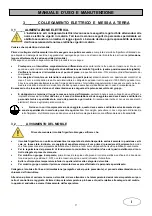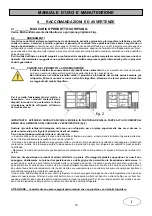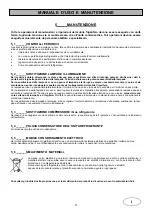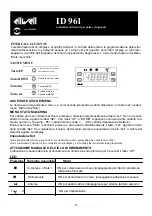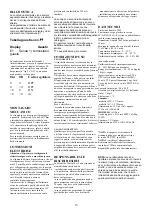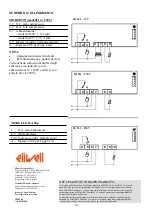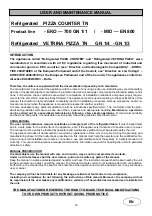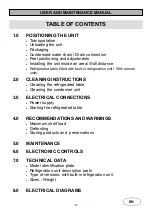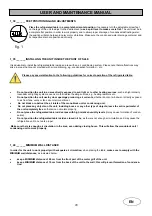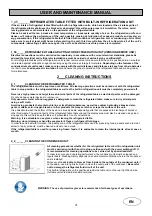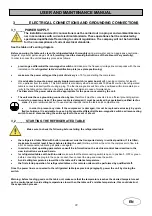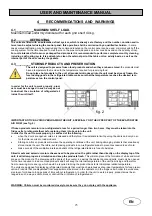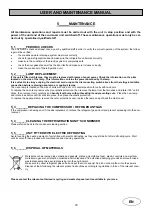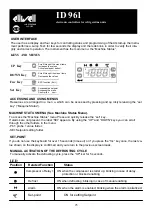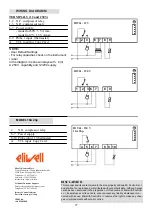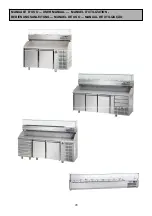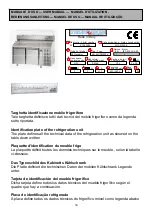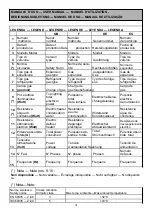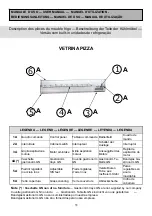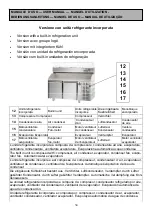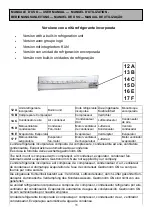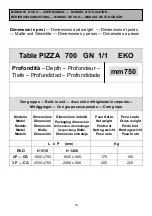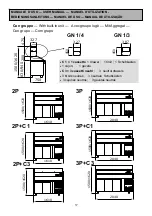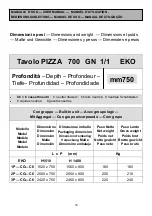
23
USER AND MAINTENANCE MANUAL
4 RECOMMENDATIONS AND WARNINGS
4.1___________MAXIMUM SHELF LOAD
.
Maximum load uniformly distributed for each grid shelf: 40 kg.
4.2 DEFROSTING
The units are fitted with an automatic defrost system, which is already set at factory and the number, duration and in-
terval can be adjusted using the control panel; this operation shall be carried out by a qualified technician
, in some
cases manual defrosting may be required and the command located on the control panel can be used, or simply switch off the
cooling system for the time required to melt the ice on the pipe coils (depends on room conditions and on the quantity of ice).
For units intended for frozen or packaged food products it is recommended to perform a complete monthly cleaning,
including a defrosting cycle. It is advisable to clean the external part of the table unit on a daily basis, as well as the
internal part of the door nearby the gaskets.
4.3_________STORING PRODUCTS AND PRESERVATION
The unit is designed to preserve frozen food products and when they are been stored,
the products must
have a temperature that is close to the temperature required for preserving food.
Do not place hot products in the unit; all products introduced into the unit must be already frozen. Be-
fore loading goods in the refrigerated table, make sure that the temperature reaches the desired tem-
perature set on the control panel.
In order for the unit to work properly, prod-
ucts must be arranged in such a way as not
to obstruct the circulation of refrigerated air
inside the unit itself.
IMPORTANT NOTICE: AVOID OVERLOADING THE UNIT, ESPECIALLY ON THE UPPER PART OF THE EVAPORATOR
AIR FLOW (see fig. 2)
If frozen products remain in non-refrigerated areas for a period longer than two hours, they must be taken into the
fridge cells to refrigerate them before storing them into back into the unit.
In order for the unit to work properly, be advised of the following:
•
when the doors are opened, cold air is released and therefore, it is advisable to limit opening the doors and only do so
for the time required to load products
•
Storing non-frozen products will worsen the operating conditions of the unit, risking damaging products that are already
stored inside the unit. Therefore, avoid placing products in non-refrigerated areas to prevent excessive loss of cold.
•
make sure all of the ventilation inlets and outlets of the refrigerated table are free of obstacles.
Sliced meats and salami or mature cheese need to be placed on the grills rather than directly on the display top of the
unit; it will allow proper air circulation and keep the products fresh.
This will also prevent the formation of white and moist
zones on the products. The drawers and the doors of the counter, as well as the cabinet doors and cells, must only be opened
for the time required to load or unload products and it will keep the internal temperature of the unit from rising and therefore
from consuming more energy, which would be required to bring the product back to its initial preservation temperature.
The units are designed for displaying refrigerated products that must reach warehouses at an ideal temperature for food preser-
vation. Products that are dispatched from suppliers must be stored in the cabinets or in the fridge cells in order to avoid exces-
sive loss of cold due to long periods of time without refrigeration. In order for the unit to work properly, products must be ar-
ranged in such a way as not to block or obstruct the circulation of refrigerated air.
WARNING: Children must be monitored closely to make sure they do not play with the appliance.
fig. 2
EN
Summary of Contents for GN 1/3
Page 15: ...Note ...
Page 29: ...Note ...
Page 43: ...43 ...
Page 49: ...Note ...
Page 50: ...Note ...
Page 51: ...Note ...

